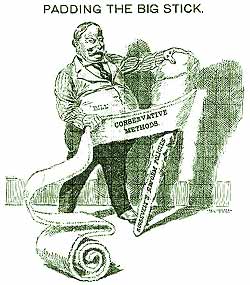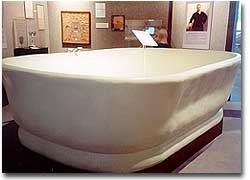43e. Passing the Torch

1908 was not a good year for Teddy Roosevelt. The nation was recovering from a financial panic that had rocked Wall Street the previous year. Many leading industrialists unjustly blamed the crisis on the President. The Congress that he had finessed in his early term was now dominated by conservative Republicans who took joy at blocking the President's initiatives. Now his time in the White House was coming to a close.
He had promised not to seek a third term when he was elected in 1904. No prior President had ever broken the two-term tradition. Roosevelt would keep his word.
Among Friends
He decided that if he could no longer serve as President, the next best option was to name a successor that would carry out his programs. He found the perfect candidate in William Howard Taft.
Taft and Roosevelt were best friends. When Roosevelt was sworn in as chief executive, Taft was serving as governor of the Philippines. Roosevelt offered his friend a seat on the Supreme Court, but his work in the Philippines and the ambitions of Mrs. Taft propelled him to decline. In 1904, he became Secretary of War and his friendship with Roosevelt grew stronger.
By 1908, Roosevelt was convinced that Taft would be the ideal successor. His support streamrollered Taft to the Republican nomination, and the fall election against the tired William Jennings Bryan proved to be a landslide victory.
Juggling Progressives and Conservatives
Upon leaving the White House, Roosevelt embarked on a worldwide tour, including an African safari and a sojourn through Europe. Taft was left to make his own mark on America. But he lacked the political skill of his predecessor to keep both the progressive and conservative wings of his party happy. Soon he would alienate one side or the other.

Unfortunately, Taft is probably most famous for getting stuck in his bathtub. His obvious obesity helped change American attitudes toward fitness.
The defining moment came with the Payne-Aldrich Tariff. Progressives hated the measure, which raised rates, and conservatives lauded it. Taft signed the bill, and his progressive supporters were furious.
The rupture widened with the Ballinger-Pinchot controversy. Richard Ballinger was Taft's Secretary of the Interior. His appointment shocked Gifford Pinchot, the nation's chief forester and longtime companion of Theodore Roosevelt. Pinchot rightly saw that Ballinger was no friend to Roosevelt's conservation initiatives. When Pinchot publicly criticized Ballinger, Taft fired Pinchot, and progressives were again outraged. The two wings of the party were now firmly on a collision course.
Taft's Progressive Reforms
Despite criticism from progressive Republicans, Taft did support many of their goals. He broke twice as many trusts in his one term as Roosevelt had broken in his two. Taft limited the workday of federal employees to 8 hours and supported the 16th Amendment to the Constitution, which empowered the Congress to levy a federal income tax. He also created a Children's Bureau and supported the 17th Amendment, which allowed for senators to be directly elected by the people instead of the state legislatures.
Still, when Roosevelt returned to America, progressives pressed him to challenge Taft for the party leadership. As 1912 approached, the fight was on.






